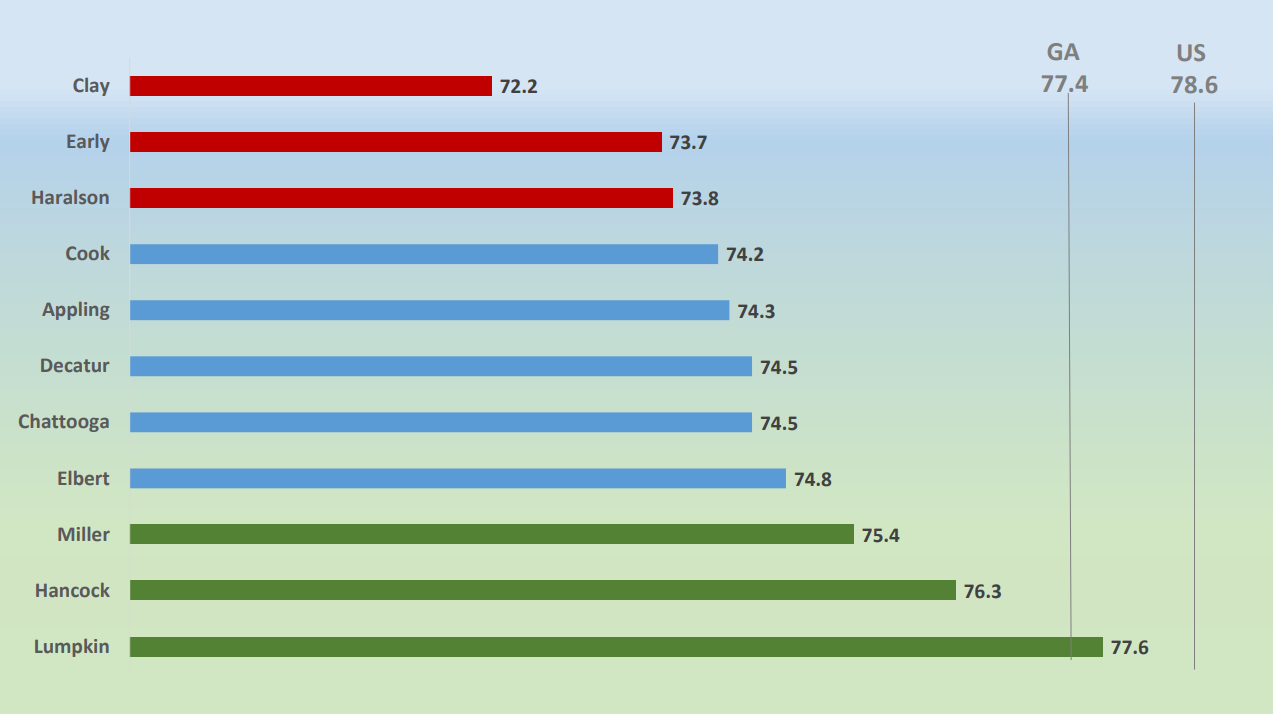Sparks, GA
United States
Cook County Family Connection utilized USALEEP data to create detailed health data reports and supporting graphics for eleven rural Georgia communities engaged in The Two Georgias Initiative network. For each of those individual counties, they mapped life expectancy data from the various census tracts; and then compiled secondary data to examine the socioeconomic, behavioral, environmental, and healthcare access correlations for each locale. These reports were then used by health leaders in each of the eleven communities to spearhead meaningful conversations with stakeholders around strategies to improve health equity.
HOW THEY USED 500 CITIES DATA
Each of the eleven health data reports began with a county map charting and comparing life expectancy data among the various census tracts within each community. The remainder of each report dissected each of those geographic areas to examine rates of poverty, low-literacy, unemployment, homelessness, crime and violence, healthcare access, environmental and geographic distinctions, and demographic characteristics. Using interesting graphics and maps, the detailed data reports created a visual image through which community stakeholders could see the effects of various health inequities on life expectancy by geographic area. Each of the eleven reports were supplemented by individualized infographics and slide presentations designed to be used by each collaborative partnership in their local efforts to increase awareness about health inequities and spark discussions about how, where, and why they should create change strategies. The Cook County Family Connection team also created an aggregate report to compare findings across 11 counties.

When the data reports were ready for public presentation, Cook County Family Connection hosted two “Place Matters” Data Workshops—one in North Georgia and another in South Georgia—where they formally presented the data findings to over fifty rural health leaders. Attendees included at least two leaders from each of the eleven communities, as well as leaders from Healthcare Georgia Foundation, the Partnership for Southern Equity, Emory Prevention Research Center, and Georgia Family Connection Partnership. Equipped with their data reports and supporting graphics and slideshow presentations, the rural health leaders from each of the eleven communities then hosted special events in their respective communities to share the data with their local leaders and stakeholders. As a result, over 300 community leaders from across eleven rural Georgia counties were educated and informed on their local life expectancy and health data so that they could begin addressing disparities and inequities. The Cook County Family Connection team detailed their findings in a high-level project evaluation.
WHAT THEY LEARNED
The Cook County Family Connection research found life expectancy data to be the nexus, the conversation starter, in coming to grips with the sometimes stunning differences in longevity within the same county and even side by side physical proximity. Mapping and viewing that data triggered important questions about why residents in certain geographic locations have a lower life expectancy. By delving into secondary data sources to answer that question, the researchers discovered contributing factors in the lower-life expectancy areas such as disproportionately high rates of poverty and illiteracy, unemployment, substandard housing, lack of transportation, high rates of crime and substance abuse, and other social determinants of health.
The impact of the research findings were critically important for the health partnerships working to improve health equity in these eleven rural Georgia communities. In some communities, there was as much as a nine-year difference in life expectancy estimates between neighborhoods that are only a few miles apart. By examining the differences in social determinants of health between such neighborhoods, leaders of the rural health partnerships were able to delve deeper into the risk factors and disparities driving lower life expectancy rates in certain areas of their communities. Most importantly, the realization of striking differences between neighborhoods within the same county led to public gatherings to talk honestly about the data. Those talks across the eleven rural communities led to an on-going process of identifying gaps, barriers, and inequities within pocket areas of each county that seem plausibly associated with lower life expectancy.
WHAT THEY RECOMMEND FOR SIMILAR PROJECTS
Cook County Family Connection has identified a few recommendations for organizations interested in conducting similar projects centering in the USALEEP data, outlined below:
- Map life expectancy estimates by census tract as the starting point, and then gather secondary data on a wide range of social determinants of health for each tract to look for correlation and causation.
- Use a broad brush to examine social determinants of health. Keep in mind that health outcomes are affected by numerous variables including education, literacy levels, economics, healthcare access, transportation, housing, health behaviors, culture, and environment.
- Consider conducting a windshield survey of every census tract included in the research. There may be environmental and geographic factors that help steer life expectancy in certain tracts, and the only way to identify those factors may be to visually examine those areas.
To learn more, follow Cook County Family Connection on Facebook. If you are interested in learning more about this team’s project approach or have specific questions regarding replicating their work in your community, please feel free to contact the Principal Investigator of this project, Zoe Myers.